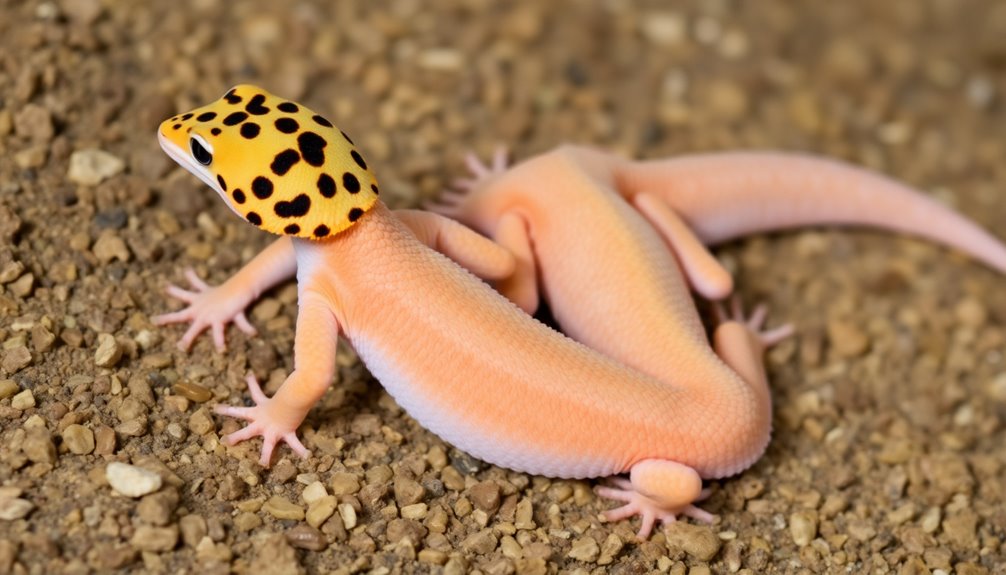To sex a crested gecko, look for distinctive physical traits. Males develop hemipenal bulges beneath the vent and pre-anal pores around four months old, while females have a smooth base with no pores. Monitoring them when they reach about 10 grams can improve your accuracy. Male geckos often have broader heads and more vibrant colors compared to females. Using good lighting or a jeweler's loop can help you see these features clearly. Understanding these traits is essential for proper care and breeding. Keep exploring for additional tips and techniques that will boost your confidence in sexing your gecko.
Key Takeaways
- Look for hemipenal bulges under the vent in males around 4 months old; females will have a smooth base.
- Check for pre-anal pores above the vent; males develop these around four months, while females typically do not.
- Use a jeweler's loop and ensure good lighting to enhance visibility for accurate sex identification.
- Observe size and shape differences; males generally have broader heads, larger bodies, and more vibrant color patterns.
- Monitor regularly as features become clearer with growth; aim for a weight of 18-25 grams for optimal clarity in identification.
Importance of Knowing the Sex
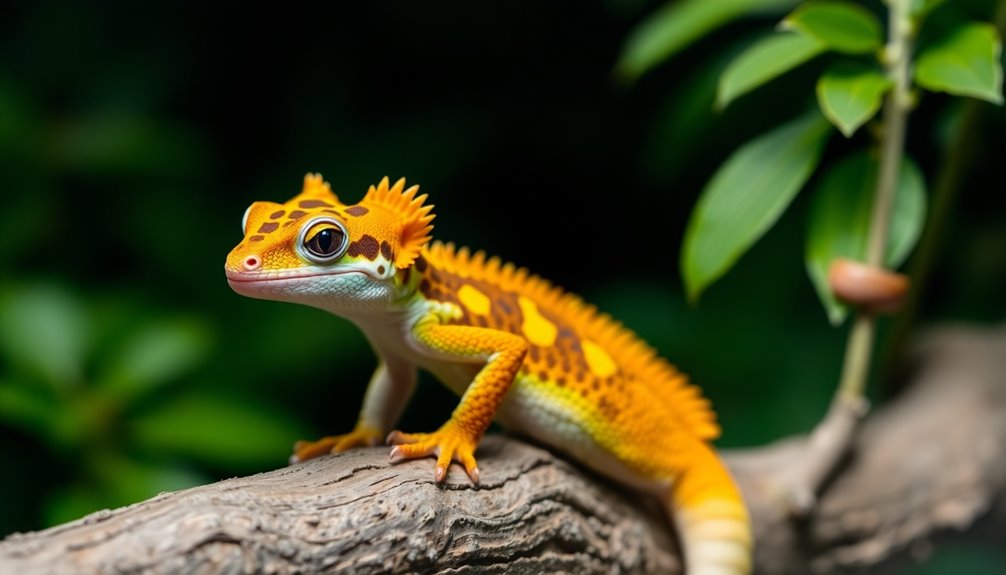
Knowing the sex of your crested gecko is vital for several reasons.
First, it's important for successful breeding programs, as knowing whether you have male crested geckos helps prevent unwanted pairings and guarantees genetic diversity. Male crested geckos are often territorial and aggressive towards one another, so proper sex identification allows you to house them separately to avoid fights.
On the other hand, female geckos can live harmoniously in groups if given enough space, but recognizing their sex is key for that. Additionally, females can lay eggs without a male, so you must provide a laying box.
Understanding your gecko's sex also helps tailor their diet and habitat setup, promoting the best health and well-being.
When to Sex a Crested Gecko

You can start sexing your crested gecko when it weighs around 6 grams, but aiming for 10 grams is better for beginners.
By about 4 months old, you'll notice key traits that help you identify whether your gecko is male or female.
Regularly checking as your gecko grows will give you more confidence in your observations.
Optimal Weight for Sexing
When it comes to sexing a crested gecko, reaching an ideal weight of around 10 grams is essential for accurate identification. At this weight, physical characteristics become more pronounced, allowing you to better observe traits like the hemipenal bulge in males. While some may try to sex geckos as early as 6 grams, waiting until they hit 10 grams yields more reliable results.
| Weight (grams) | Sexing Accuracy | Key Characteristics |
|---|---|---|
| 6 | Low | Unclear traits |
| 8 | Moderate | Beginning traits visible |
| 10 | High | Definitive traits |
| 12+ | Very High | Fully developed features |
Age Milestones for Accuracy
At around 4 months of age, crested geckos start to display initial sexual characteristics, making this a good time for your first attempts at sexing. You can observe hemipenal bulges in males and pre-anal pores in both sexes around this age.
However, by 9 to 10 months, your geckos typically achieve sexual maturity, and the differences in sex become more pronounced, making identification easier.
For the most accurate results, wait until your geckos weigh between 18-25 grams, as males will have more developed bulges by then. This guarantees you'll have a clearer understanding of their sex, helping you make informed decisions for breeding or housing arrangements.
Identifying Hemipenal Bulges
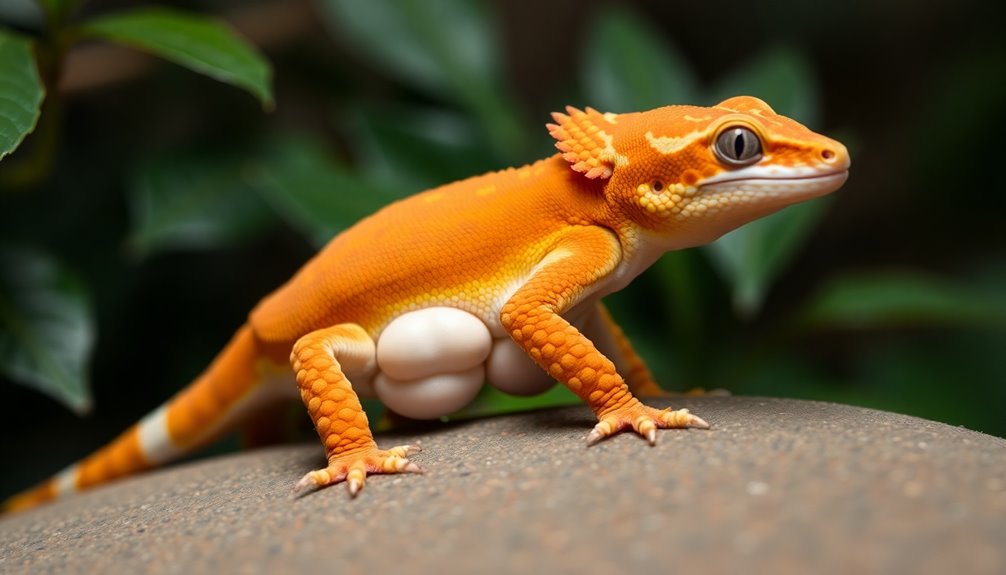
Identifying hemipenal bulges is a crucial step in determining the sex of your crested gecko. These bulges typically become noticeable around 4 months of age in males and grow more pronounced as they mature.
Located directly beneath the vent, hemipenal bulges appear as round, bubble-shaped structures unique to males. In contrast, females will have a smooth base without any bulge.
To spot these features effectively, use good lighting or place your gecko in a clear-bottomed container for better visibility. Regular checks during growth stages can help you confirm the sex of your gecko, especially as the bulge becomes more apparent with age.
Recognizing Pre-Anal Pores

To recognize pre-anal pores, you'll want to look for small black dots just above the vent, which indicate a male crested gecko.
While males develop clear pores around four months old, females typically lack these features, making them easier to identify.
Using good lighting and a jeweler's loop can help you view these pores more clearly, but be cautious, as some females might show pseudo-pores that can confuse the identification process.
Identifying Male Pores
Recognizing male crested geckos involves spotting their unique pre-anal pores, which form a distinct line above the vent. These pores typically become visible around four months of age and are more pronounced by nine to ten months.
Look for small black dots that signify male pores; they're essential for attracting potential mates. To guarantee you're identifying these pores correctly, use good lighting and consider a jeweler's loupe for enhanced visibility, especially in younger geckos.
Female Pore Characteristics
While male crested geckos are known for their prominent pre-anal pores, female geckos typically show fewer and less noticeable features in that area.
When examining a female gecko, you might find that the pre-anal pores are either faint or completely absent. In some cases, females may exhibit pseudo-pores, which can be misleading since these aren't true pores and don't serve the same purpose as those in males.
The absence of a clear line of pores is a strong indicator that you're looking at a female. If any pores are present, they'll likely be smaller and inconsistent compared to the distinct black line seen in males, confirming the female's sex.
Viewing Techniques for Pores
A clear understanding of how to view pre-anal pores is essential for accurately determining the sex of your crested gecko. Confirm the gecko is still and positioned comfortably, preferably under good lighting. Use a magnifying glass or jeweler's loop for a closer look at the small black dots located just above the vent and between the back legs.
| Sex | Pores Presence | Hemipenal Bulge |
|---|---|---|
| Male | Clear, pronounced | May be visible |
| Female | Few or none | Not visible |
| Age | 4 months or older | Later development |
| Pores | Distinguishable | False pores common |
| Lighting | Good or flashlight | Helps visibility |
With these techniques, you can effectively distinguish between male and female crested geckos.
Additional Sex Indicators
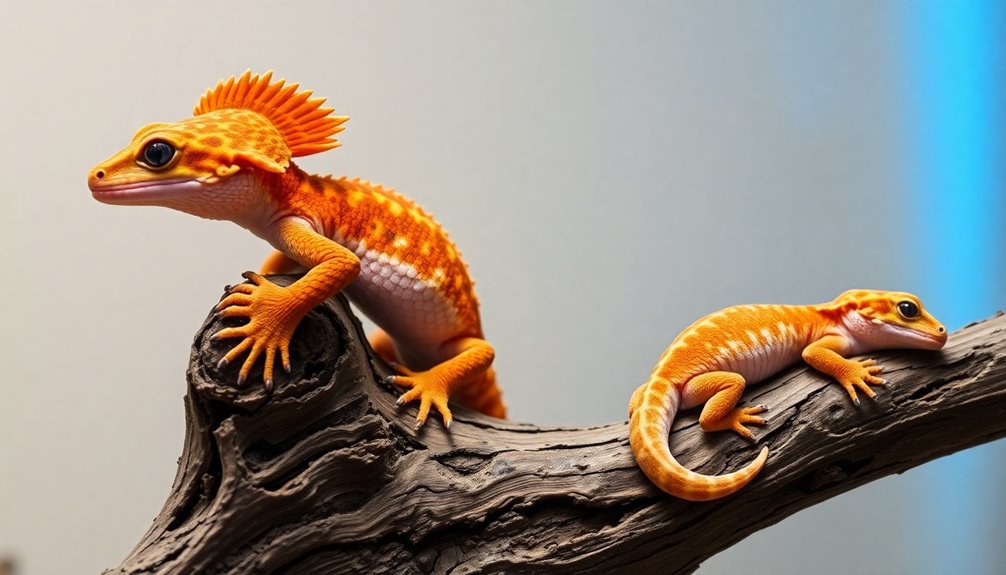
When determining the sex of a crested gecko, you'll want to contemplate additional indicators beyond the obvious physical traits.
Males usually have a broader head and larger body size, making them stand out. You can also check for a line of pre-anal pores above the vent, which appears as small dots and is a reliable male indicator. Use a jewelers loupe to get a closer look if needed.
Cloacal spurs are another factor; males typically have larger spurs than females.
Finally, while coloration varies, males often show more vibrant patterns. By observing these traits on either side of your gecko, you can confidently identify its sex without solely relying on the primary characteristics.
Behavioral Signs of Sex
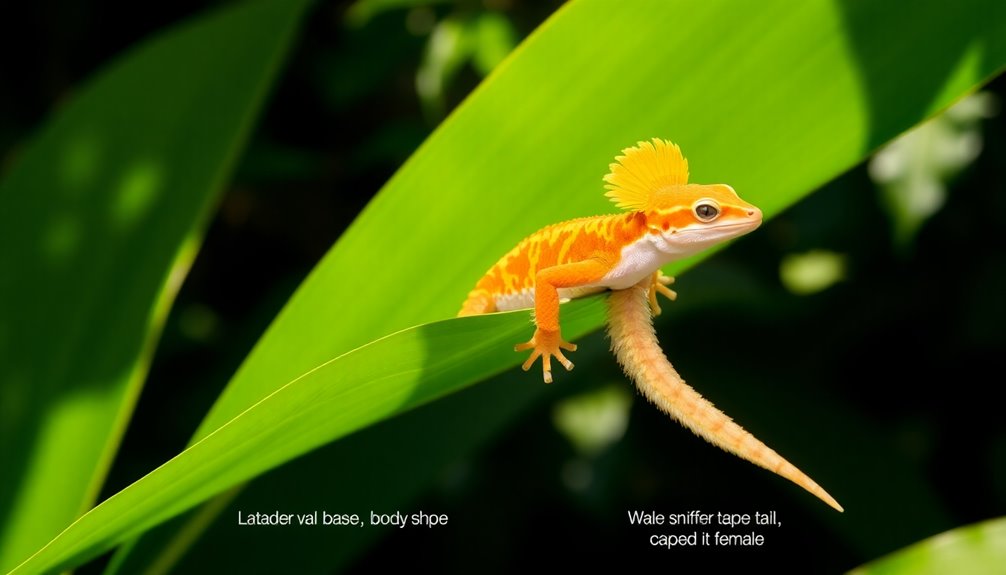
Understanding the behavioral signs of sex in crested geckos can help you identify their gender more accurately.
Males often display territorial behaviors, such as head bobbing and vocalizations, especially during mating season. You might notice courtship behaviors like tail curling and body waving, which males use to attract females.
Keep an eye out for aggressive interactions between males, as they tend to assert dominance, while females usually remain more passive and social.
During breeding season, males become more active and exhibit heightened interest in their surroundings.
Observing these social dynamics in a mixed-gender setting can offer valuable insight into the sex of your geckos, making it easier for you to distinguish between them.
Challenges in Accurate Sexing

Accurately sexing crested geckos can be tricky, especially for new owners. Young males often don't show hemipenal bulges until they reach weights of 15 grams or more, which makes early identification tough.
Additionally, females can have pseudo-pores that resemble male pre-anal pores, leading to potential confusion during sex determination. Growth rates vary among individual geckos, so some may develop characteristics sooner than others.
Many new owners find it hard to identify pores in very young geckos since these traits typically don't fully develop until around 4 months of age.
To improve accuracy, observe your gecko multiple times as it grows and consider using tools like a jeweler's loop for better clarity in sex identification.
Resources for Further Guidance
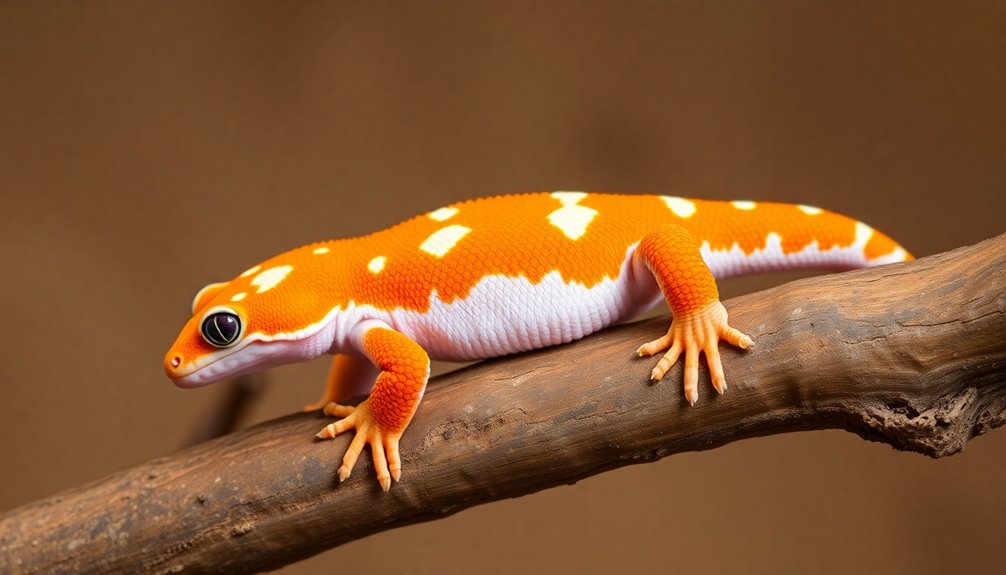
Finding reliable resources can make a significant difference in your ability to sex a crested gecko correctly. Here are some great options to evaluate:
| Resource Type | Description |
|---|---|
| ReptiFiles.com | Extensive care manuals with guides on sex determination. |
| Online Forums | Communities where you can share experiences and learn from other gecko keepers. |
| YouTube Videos | Visual demonstrations of sexing techniques, including pore and bulge identification. |
Additionally, consulting experienced breeders or reptile veterinarians can provide personalized insights. Reference books on reptile husbandry often include detailed sections on sexual dimorphism, helping you understand the differences between males and females effectively. Utilize these resources to enhance your skills!
Frequently Asked Questions
How to Tell if a Crested Gecko Is a Male or Female?
To tell if your crested gecko is male or female, look for key physical traits.
Males usually have a noticeable bulge at the base of their tail, which develops with age. You can also check for pre-anal pores, small black dots above the vent, that are more prominent in males.
If you observe territorial behaviors or vocalizations, it's likely you've got a male.
Females, on the other hand, lack these distinctive features.
How Can I Tell if My Gecko Is Male or Female?
To tell if your gecko is male or female, you can check a few key features.
Look for a noticeable bulge at the base of the tail; that's usually a sign of a male.
Also, examine the area beneath the back legs for pre-anal pores—males have a distinct line of pores.
Additionally, observe their behaviors; males might display more territorial actions, while females are typically more passive and rounded.
At What Age Can Crested Geckos Be Sexed?
You can start sexing crested geckos as early as 4 months old, when certain physical traits begin to show.
By around 6 grams, you might notice distinguishing features, but waiting until they reach about 10 grams is ideal for more accurate identification.
During this time, males typically develop hemipenal bulges and pre-anal pores, making it easier for you to determine their sex.
As they mature, these characteristics become clearer by 9 to 10 months.
How Do I Know What Crested Gecko I Have?
You might think your crested gecko is just a colorful pet, but it's a unique species with its own traits.
To identify it, check its size, typically 7-10 inches, and look for its distinctive fringed skin.
Observe its behavior; they're quite docile and love to jump around.
Researching their morphs and patterns will also help you pinpoint exactly which crested gecko you have.
It's more than just a pretty face!
Conclusion
In the world of crested geckos, knowing their sex is like revealing a secret door to better care and understanding. You've learned to spot hemipenal bulges and pre-anal pores, but remember that patience and practice are key. The journey of sexing your gecko might come with challenges, but it's a rewarding path that deepens your bond. With these tips in hand, you're ready to navigate this fascinating aspect of gecko ownership with confidence.

